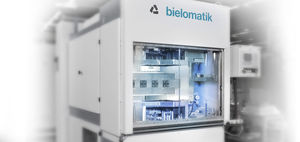
- Industrial machines and equipment
- Welding and Assembly
- Laser welding machine
- Bielomatik Leuze GmbH + Co.KG
Laser welding machine automaticfor plasticscircular

Add to favorites
Compare this product
Characteristics
- Technique
- laser
- Operational mode
- automatic
- Applications
- for plastics
- Other characteristics
- circular
Description
Established process for small and large series: abrasion- and shock-free use with a very small heat-affected zone.
Quasi-simultaneous
- The different absorption characteristics of the joining partners form the basis for laser welding. Many thermoplasts are sufficiently transparent for use with lasers and can even be colored as required
- As a rule, laser welding results in precise, visually perfect weld seams that can even be used as a design element. In addition, high weld strengths are attained, approximating the base material strengths
- In quasi-simultaneous laser welding, the laser beam is led along the welding contour with the help of scanner mirrors with high traversing rate of up to 10 m/s (depending on the focal length)
- Molded part tolerances can be melted down and pressed into the weld bead
Laser-contour-welding
- The robot’s freedom of movement makes it also possible to weld complex three-dimensional contours.
- Because the laser runs along the weld seam slowly, melt distance is eliminated and weld seams form without bead
- Delicate small parts requiring vibration-free welding. Housings containing thermally sensitive materials. It is often used in the following areas:
- Automotive industry / home appliance and white goods industry / electrical engineering / electronics / medical and pharma technology
VARIANTS
- Modularly designed standard series for various component sizes and automation concepts – all adjustable to customer requirements
VIDEO
Catalogs
No catalogs are available for this product.
See all of Bielomatik Leuze GmbH + Co.KG‘s catalogsOther Bielomatik Leuze GmbH + Co.KG products
Plastic Welding
Related Searches
- Welding system
- Automatic welding system
- Laser welding system
- Metal welding system
- Plastic welding system
- Standalone welding system
- Steel welding system
- Ultrasonic welding system
- Integrated welding system
- Hydraulic welding machine
- Vertical welding system
- Horizontal welding system
- Hot plate welding machine
- Multi-head welding machine
- Vibrating welding machine
- Servo-driven welding system
- Circular welding machine
- Infrared welding machine
- Thermoplastic welding machine
*Prices are pre-tax. They exclude delivery charges and customs duties and do not include additional charges for installation or activation options. Prices are indicative only and may vary by country, with changes to the cost of raw materials and exchange rates.






